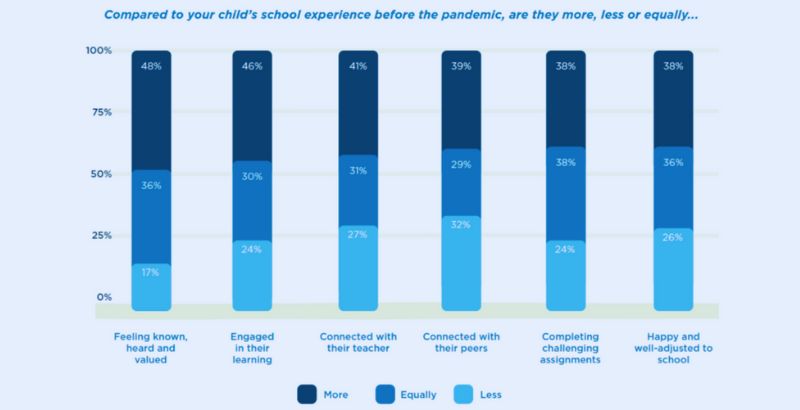Analysis: Pandemic Pods Were Everywhere — Until They Weren’t. Here’s What Their Popularity Means for the Future of Education

Get stories like these delivered straight to your inbox. Sign up for The 74 Newsletter
At the height of the COVID-19 pandemic, Holly Daniels’ third grade son and second-grade daughter could be found in the backyard building a treehouse. After spending the morning completing school assignments remotely with help from a hired instructor, they would join a handful of other kids in their California suburb to apply their learning outside, in the ultimate hands-on task.
The construction project was the combined brainchild of their parents — among them an architect, a carpenter and Daniels, a former neonatal intensive care nurse with a passion for woodworking. All of them worked from home during the pandemic and took their children’s learning into their own hands like never before.
In Daniels’s words, the result was a “momentous occasion in childhood” for her kids and the “shining light, the silver lining” of the pandemic. She and some other parents wanted it to continue and even explored homeschooling options.
Today, however, like many students who discovered unexpected joys during pandemic learning, Daniels’s kids are back at school along with their podmates. She still feels the pod provided a better educational setting and would love to do it again, but with schools back open and a new job that requires her to work onsite, she said it felt “complicated” and a “big undertaking” to try to remake the experience.
Since fall 2020, researchers at the Center on Reinventing Public Education have studied hundreds of self-organized learning pods that launched during the pandemic. As our latest report shows, most families sought safe spaces for learning and socialization for children displaced by school closures — and more than half of families and three-quarters of instructors we surveyed created learning environments they preferred over school. Still, their efforts proved fleeting. Once schools reopened for in-person learning, most pods receded.
Yet, families who participated in these pandemic learning communities saw possibilities they can’t unsee. Schools, district leaders and state policymakers working to recover from COVID-19 can draw useful lessons from those pods and the factors that caused many of them to quickly vanish.
Pods made space for stronger relationships and instruction tailored to each student’s needs
Over two-thirds of families that responded to our survey cited tangible benefits for their child, such as being more engaged in learning, completing more challenging assignments or feeling happier overall compared with their previous school experiences. Nearly half of families felt their child was more deeply connected to instructors and peers in the pod and received more individualized instruction that met their needs compared with their pre-pandemic schools.
One parent, who also served as her pod’s instructor, contrasted the personal attention each student received with the “anonymity” of her child’s former school: “There’s no getting lost in this. In the pod, there’s no sneaking by without getting your work done like there would be in school. I notice.”
In the majority of pods in our study, students remained enrolled in their public schools and connected to certified teachers through district-provided remote learning. However, nearly half of families we surveyed said their pod instructors also created and delivered their own lessons from scratch, and 20 percent operated fully independently of schools’ remote learning programs.
For these pods, independence turned out to be a strength. We asked families whether they were more satisfied with their pods than their prior school experience. Families whose pods had no connection to schools’ remote learning were more than twice as likely as other families to report greater satisfaction with their pods.
One of the key benefits teachers and parents discovered in pods — the flexibility to tailor learning to students’ needs and interests — was undermined when students spent long hours tethered to online schools.
Pods broadened the pool of educators and provided more flexible teaching environments
Pods attracted broad and often untapped pools of individuals who were interested in supporting student learning. More than half of the instructors in our sample were not working as certified classroom teachers in February 2020. They previously were tutors, nannies, paraprofessional educators or retired teachers. Despite their lack of teaching credentials, many of them brought other skills to the table — like the former camp counselor with a knack for building relationships, the homeschooler adept at managing multi-age groups and parents like Daniels who drew on their hobbies and trade skills to engage students in learning.
Families largely felt satisfied with their instructors, as 4 in 5 said their child was as likely or more likely to receive high-quality instruction in their pod then at school.
Instructors consistently reported more flexibility in their work and more opportunities to deepen relationships with students and families. Strikingly, one-third of the instructors we interviewed said that after their pod experience, they lost interest in pursuing more traditional versions of teaching, which they perceived as rigid and bureaucratic.
Pods suffered without supportive infrastructure
Operating off the grid gave pods flexibility that parents and instructors valued, but it also disconnected them from broader systems of support. Nearly two-thirds of instructors reported decreased opportunities for professional development. They had no principal they could call on to placate an angry parent. They were on their own.
Families, too, felt frustrated by barriers that cut off their pod from the rest of the public school system. Some reported difficulty collaborating with students’ remote teachers, or getting their children access to special education services or assessments.
Additionally, both families and instructors felt their pandemic learning arrangements were less secure. If a change in one family’s circumstances or a conflict over operations forced a pod to split, the instructor could be out of a job with no recourse and families could be left scrambling for child care and remote learning support.
What system leaders should carry forward
System leaders can invite continued partnerships with the families and community organizations that stepped up to support small group learning during the pandemic. These collaborations could draw on the strengths of each to build new, diversified teams of educators, form stronger connections with families, offer hands-on learning experiences or support wraparound services.
Some districts have already embraced the possibilities of podlike approaches to provide personalized learning in schools or create district-sponsored learning hubs, which build more flexibility into school days to give students time to explore their interests or receive extra help. For example, Guilford School District in North Carolina is using small, podlike learning environments after school to support high school students with tutoring, social-emotional well-being and access to college-level coursework — all facilitated by teachers. In California, the Oakland Reach has partnered with the city’s school district to empower families and provide students in online schools with vital support during the day.
State policymakers also can play an important role in building a more supportive infrastructure for families that are increasingly choosing to learn outside of the traditional education system. Supports like sharing high-quality curricular resources, opening access to assessments and special education supports, ensuring public funding follows students to whatever learning environment they choose and creating more conducive regulatory environments can help ensure that families in pods, microschools and homeschool co-ops have equitable access to high-quality learning opportunities.
The families in Daniels’s pod are planning a summer program and agreed that if schools shut down again, they would pick up where they left off. “It would be a no-brainer,” she said. But there are also signs that her year of podding changed her beliefs about education more fundamentally. She has been thinking about a homeschooling pod and says she now realizes “it’s more than possible, it’s very do-able,” even for parents who work full time. She has a host of ideas about what she would do again, or do differently, if given the chance.
But will she? It may well depend on how state policymakers and education system leaders heed the lessons of pandemic pods and design policies to support podlike learning.
Jennifer Poon is an education consultant and fellow at the Center on Innovation in Education.
Travis Pillow is an innovation fellow and senior writer at the Center on Reinventing Public Education.
Ashley Jochim is a principal at the Center on Reinventing Public Education.
Get stories like these delivered straight to your inbox. Sign up for The 74 Newsletter

;)
